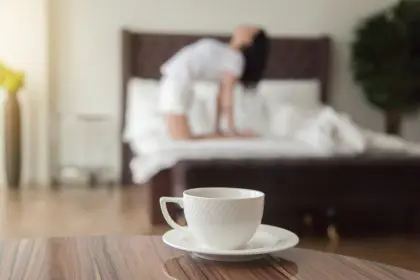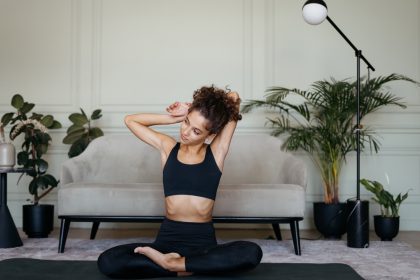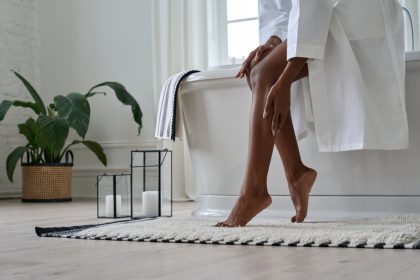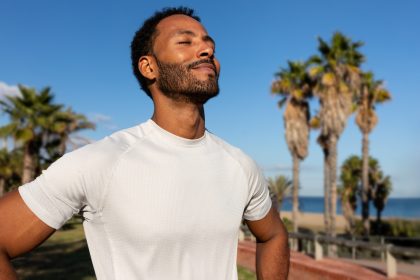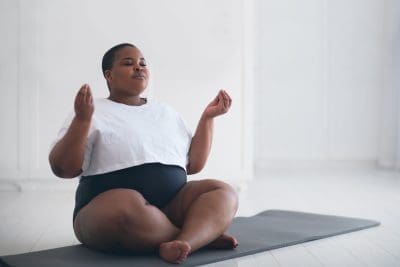That feeling of stiffness when you first wake up isn’t just in your imagination. After hours of limited movement during sleep, your body needs gentle reawakening to perform at its best. Morning stretching might be the missing element in your daily routine that could transform how you feel all day long.
Why your body feels stiff in the morning
That familiar morning tightness has a scientific explanation. During sleep, your muscles remain relatively inactive for extended periods, causing temporary stiffness in joints and muscles. This natural response to inactivity creates that restricted feeling when you first attempt to move.
“Your body experiences decreased circulation during sleep, which contributes to morning stiffness,” explains one physical therapist who works with professional athletes. Without movement, fluid accumulates in soft tissues, creating that characteristic morning heaviness and reduced flexibility.
This stiffness isn’t just uncomfortable—it can affect your mobility and energy levels throughout the day when left unaddressed. The good news? A strategic morning stretch routine can counteract these effects within minutes.
The science behind morning mobility
Morning stretching delivers benefits beyond simple flexibility improvements. When you engage in gentle stretching after waking, your body responds with increased blood circulation to muscles and joints. This enhanced blood flow carries oxygen and nutrients throughout your system, helping muscles recover from overnight stiffness.
Research published in the Journal of Physical Therapy Science demonstrates that consistent morning stretching can significantly improve range of motion and reduce muscle tension. These physical benefits translate into noticeable improvements in daily function and comfort.
Beyond the physical advantages, morning stretching triggers neurological benefits. The mind-body connection activated during stretching helps stimulate mental alertness and improve cognitive function. Many regular practitioners report greater mental clarity and focus after their morning mobility routines.
The 7 most effective morning stretches
After analyzing recommendations from physical therapists, movement specialists, and research studies, these seven stretches emerge as particularly effective for morning mobility. Together, they form a comprehensive routine that addresses the most common areas of morning stiffness.
Gentle spinal awakening series
The spine houses your central nervous system and affects mobility throughout your entire body. These movements gently reintroduce movement to this crucial structure.
Cat-cow flow
Begin on hands and knees with wrists under shoulders and knees under hips. Inhale while dropping your belly toward the floor, lifting your chest and gaze (cow position). Exhale while rounding your spine toward the ceiling, tucking your chin (cat position). Flow between these positions for 30-60 seconds, moving with your breath.
This gentle movement improves spinal flexibility, relieves tension between vertebrae, and helps rehydrate spinal discs after the overnight compression of sleep.
Thoracic rotation stretch
Lie on your side with knees bent at 90 degrees and arms extended straight in front of you. Keeping your knees together and on the floor, slowly rotate your top arm open in a wide arc until it reaches the opposite side of your body, following the movement with your gaze. Hold for 5-10 seconds, then return to starting position. Repeat 5 times per side.
This movement targets mid-back stiffness, improves rotation, and helps counteract the forward-hunched position many people maintain during sleep and daily activities.
Lower body tension relievers
Morning stiffness commonly affects the hips and legs, which bear much of our body weight throughout the day. These stretches specifically target these areas.
Figure four hip opener
Lie on your back with knees bent and feet flat on the floor. Cross your right ankle over your left thigh, creating a figure-four shape. Grasp behind your left thigh and gently pull toward your chest until you feel a stretch in your right hip. Hold for 30 seconds, then switch sides.
This position targets the deep hip rotators, including the piriformis muscle, which commonly contributes to lower back discomfort and sciatica symptoms when tight.
Hamstring strap stretch
Lie on your back and extend one leg toward the ceiling. Place a belt, strap, or towel around the ball of your foot and gently pull to straighten your leg while keeping your back flat on the floor. Hold for 30 seconds per leg.
This stretch targets the hamstrings, which tend to shorten during sleep and contribute to lower back tension when tight. The strap provides gentle assistance without straining.
Full-body awakening moves
These stretches create integration between body segments for improved overall mobility.
Standing side reach
Stand with feet hip-width apart. Raise your right arm overhead and bend sideways to the left, creating a gentle stretch along your right side body. Hold for 15-20 seconds, then repeat on the opposite side.
This movement opens the intercostal muscles between ribs, improves lateral flexibility, and encourages deeper breathing—all beneficial for increasing morning energy.
Downward dog pose
Start on hands and knees, then lift your hips toward the ceiling while straightening your legs and pressing your heels toward the floor. Keep your head between your arms, creating an inverted V shape with your body. Hold for 30 seconds, pedaling your feet gently if desired.
This yoga-inspired position provides a gentle full-body stretch, lengthening the spine, hamstrings, calves, and shoulders simultaneously. The mild inversion also increases blood flow to the brain for improved alertness.
Standing quad stretch with support
Stand near a wall or chair for balance. Bend your right knee and bring your foot toward your buttocks, grasping your ankle with your right hand. Keep knees close together and maintain a neutral spine position. Hold for 20-30 seconds per leg.
This stretch targets the quadriceps muscles and hip flexors, which commonly tighten during sleep, especially for side sleepers. Keeping these muscles flexible helps maintain proper posture throughout the day.
Making morning stretching a sustainable habit
Knowing the right stretches is only half the equation—consistency is what delivers lasting benefits. Research published in the British Journal of Sports Medicine suggests that improvements in flexibility require regular practice, with noticeable changes appearing after 3-4 weeks of consistent stretching.
Start by integrating just 5 minutes of stretching into your existing morning routine. This modest time commitment removes the barrier of feeling overwhelmed while still providing significant benefits. As this becomes habitual, you can gradually extend the duration to 10-15 minutes for more comprehensive results.
Finding the right timing matters too. Some people prefer stretching immediately after waking, while others find it more beneficial after a warm shower when muscles are more pliable. Experiment to discover what works best with your schedule and body response.
Using environmental cues can strengthen this habit. Place a yoga mat beside your bed as a visual reminder, or pair stretching with another established morning routine like brewing coffee or brushing teeth. This technique, known as habit stacking, leverages existing patterns to establish new behaviors more easily.
Safety considerations for morning mobility
While morning stretching benefits most people, certain precautions ensure safe practice. Never force your body into painful positions—stretching should create a sensation of tension but not sharp pain. Breathe normally throughout each movement rather than holding your breath, which can increase tension.
Those with existing medical conditions should consult healthcare providers before beginning any new physical routine. Certain stretches may need modification for individuals with specific limitations or injuries.
Morning stiffness that persists throughout the day, worsens over time, or includes joint swelling might indicate underlying health concerns requiring medical attention. Use stretching as a complement to, not replacement for, appropriate healthcare.
The ripple effect on daily wellness
The benefits of morning stretching extend far beyond the few minutes spent in motion. Regular practitioners report improvements in posture throughout the day, increased energy levels, and reduced stress—all contributing to enhanced overall wellness.
Physical therapists note that maintaining muscle flexibility helps prevent compensatory movement patterns that can lead to pain and injury. By starting your day with intentional movement, you’re essentially pre-programming your body for better function.
Many people discover that morning stretching creates a positive ripple effect, encouraging other healthy habits throughout the day. The body awareness developed through regular stretching often leads to improved posture during daily activities, more conscious movement patterns, and greater attention to physical comfort.
Perhaps most significantly, morning stretching establishes a pattern of self-care that acknowledges your body’s needs. This simple practice represents a meaningful investment in your physical wellbeing that requires minimal time yet yields substantial returns.
From occasional stretcher to daily practitioner
Transforming your mornings with stretching doesn’t require dramatic lifestyle changes or special equipment. By dedicating just a few minutes each morning to these seven key stretches, you can address common areas of tension, improve flexibility, and set a positive tone for your entire day.
The body stiffness you experience upon waking isn’t inevitable—it’s simply a signal that your muscles and joints need attention after hours of inactivity. Responding to this need through intentional stretching can transform not only how you feel in the morning but your physical comfort and energy throughout the day.
Start small, remain consistent, and notice how this simple practice gradually reshapes your experience of mornings. Rather than struggling against morning stiffness, you’ll be flowing through your day with greater ease, flexibility, and energy.




